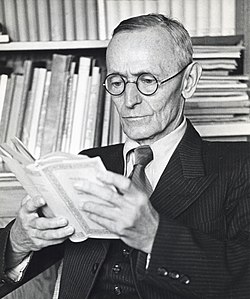Hermann Hesse Quote
For me, trees have always been the most penetrating preachers. I revere them when they live in tribes and families, in forests and groves. And even more I revere them when they stand alone. They are like lonely persons. Not like hermits who have stolen away out of some weakness, but like great, solitary men, like Beethoven and Nietzsche. In their highest boughs the world rustles, their roots rest in infinity; but they do not lose themselves there, they struggle with all the force of their lives for one thing only: to fulfil themselves according to their own laws, to build up their own form, to represent themselves. Nothing is holier, nothing is more exemplary than a beautiful, strong tree. When a tree is cut down and reveals its naked death-wound to the sun, one can read its whole history in the luminous, inscribed disk of its trunk: in the rings of its years, its scars, all the struggle, all the suffering, all the sickness, all the happiness and prosperity stand truly written, the narrow years and the luxurious years, the attacks withstood, the storms endured. And every young farmboy knows that the hardest and noblest wood has the narrowest rings, that high on the mountains and in continuing danger the most indestructible, the strongest, the ideal trees grow.
For me, trees have always been the most penetrating preachers. I revere them when they live in tribes and families, in forests and groves. And even more I revere them when they stand alone. They are like lonely persons. Not like hermits who have stolen away out of some weakness, but like great, solitary men, like Beethoven and Nietzsche. In their highest boughs the world rustles, their roots rest in infinity; but they do not lose themselves there, they struggle with all the force of their lives for one thing only: to fulfil themselves according to their own laws, to build up their own form, to represent themselves. Nothing is holier, nothing is more exemplary than a beautiful, strong tree. When a tree is cut down and reveals its naked death-wound to the sun, one can read its whole history in the luminous, inscribed disk of its trunk: in the rings of its years, its scars, all the struggle, all the suffering, all the sickness, all the happiness and prosperity stand truly written, the narrow years and the luxurious years, the attacks withstood, the storms endured. And every young farmboy knows that the hardest and noblest wood has the narrowest rings, that high on the mountains and in continuing danger the most indestructible, the strongest, the ideal trees grow.
Related Quotes
Certainly we can say that the pace of modern life, increased and supported by our technology in general and our personal electronics in particular, has resulted in a short attention span and an addict...
To begin to know ourselves we must have sincere conversations with ourselves as if with a good friend. We must answer without reserve, listen without judgement, and accept without condition. That is s...
About Hermann Hesse
Hesse was born in 1877 in Calw, a town in Germany's Northern Black Forest. His father was a Baltic German and his grandmother had French-Swiss roots. As a child, he shared a passion for poetry and music with his mother, and was well-read and cultured, due in part to the influence of his polyglot grandfather.
As a youth, he studied briefly at a Protestant boarding school, the Evangelical Seminaries of Maulbronn and Blaubeuren, where he struggled with bouts of depression and once attempted suicide, which temporarily landed him in a sanatorium. Hesse completed Gymnasium and passed his examinations in 1893, when his formal education ended. An autodidact, Hesse read theological treatises, Greek mythology, Johann Wolfgang von Goethe, Gotthold Ephraim Lessing, Friedrich Schiller, and Friedrich Nietzsche after his formal education concluded. His first works of poetry and prose were being published in the 1890s and early 1900s with his first novel, Peter Camenzind, appearing in 1904.
